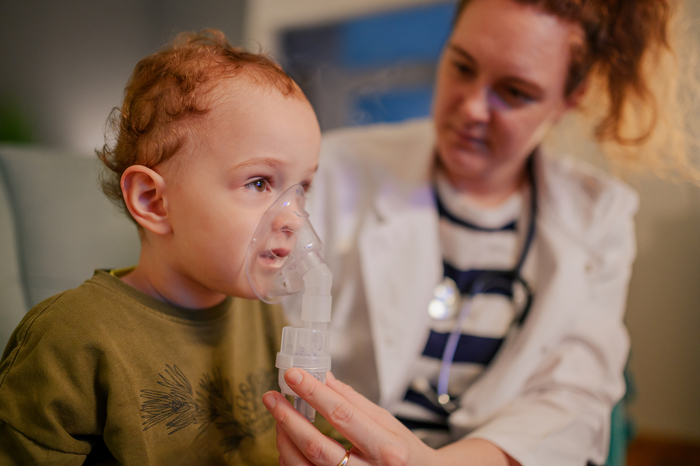Key points
- Bronchiolitis is a common respiratory condition in infants and young children, primarily caused by the respiratory syncytial virus (RSV).
- Symptoms include bluish skin, breathing difficulty, persistent cough, fatigue, fever, and rapid breathing.
- Most cases of bronchiolitis are mild and can be treated at home, but severe cases may require hospitalization.
- Parents should monitor their child's symptoms closely and seek medical attention if they observe any concerning changes.
- Infants' susceptibility to bronchiolitis can increase due to exposure to secondhand smoke, crowded living conditions, or premature birth.

What Are the Causes of Bronchiolitis?
Bronchiolitis predominantly affects infants and children under the age of two, with the highest incidence occurring between three to six months of age, according to the CDC. They explain that during this developmental stage, children's immune systems are still maturing, making them more vulnerable to respiratory infections. The primary cause of bronchiolitis is the respiratory syncytial virus (RSV), a highly contagious virus that spreads easily through respiratory droplets when an infected person coughs or sneezes. In addition to RSV, other viruses such as rhinovirus, adenovirus, and parainfluenza virus can also lead to bronchiolitis, but RSV remains the most common culprit.
The susceptibility of infants to bronchiolitis is further heightened in certain situations, such as exposure to secondhand smoke, crowded living conditions, or being born prematurely. These factors can compromise their respiratory health and increase the likelihood of viral infections. By understanding the causes and risk factors associated with bronchiolitis, parents can better protect their children and seek timely medical intervention when necessary.
There are old wive’s tales that cold weather can cause illnesses like bronchiolitis, however this is not entirely true. While exposure to cold temperatures for a long period of time may slightly weaken the immune system, it cannot cause you to get sick, with pneumonia or other respiratory illnesses, according to the CDC.
What Are the Main Symptoms of Bronchiolitis?
Recognizing these symptoms early is crucial for parents, as it allows for timely medical intervention and appropriate care, according to the CDC. They note that understanding what to look for can help parents differentiate bronchiolitis from other respiratory illnesses and ensure their child receives the necessary support.
Symptoms of Bronchiolitis:
-
Bluish skin due to lack of oxygen (cyanosis)
-
Breathing difficulty, including wheezing and shortness of breath
-
Fatigue or lethargy
-
Fever
-
Retraction of muscles around the ribs as the child struggles to breathe
-
Widening of the nostrils during inhalation
-
Rapid breathing or increased respiratory rate
These symptoms can develop gradually and may worsen over time, so it's important for parents to monitor their child's condition closely and seek medical attention if they notice any concerning signs.
How Is Bronchiolitis Diagnosed?
Accurate diagnosis is essential for determining the appropriate course of treatment and ensuring the best care for the child, according to the CDC. They note that healthcare providers typically rely on a combination of clinical evaluation and diagnostic testing to assess the severity of the illness and identify the underlying cause.
Tests Needed to Diagnose Bronchiolitis:
-
Chest X-ray: To visualize the lungs and check for signs of infection or other complications.
-
Viral Testing: To identify the specific virus causing the infection, often through nasal swabs or aspirates.
-
Blood Tests: To assess overall health and check for signs of infection or inflammation.
These diagnostic tools help healthcare professionals evaluate the child's condition effectively and develop an appropriate treatment plan tailored to their needs.
How Do You Treat Bronchiolitis?
Most cases of bronchiolitis are mild and can be treated at home, according to the CDC. They explain that parents should focus on providing a comfortable environment and ensuring their child stays hydrated. It's important to be vigilant and recognize when symptoms worsen, as some children may require hospitalization for more severe manifestations, such as difficulty breathing or significant fatigue. Signs that warrant immediate medical attention include rapid breathing, bluish skin, or retractions of the chest muscles, according to the CDC.
To relieve bronchiolitis symptoms, the CDC notes that parents can implement several strategies. Keeping the child well-hydrated with fluids can help thin mucus and ease breathing. Using a humidifier in the child’s room can add moisture to the air, which may soothe irritated airways. Saline nose drops can also be beneficial for clearing nasal congestion, making it easier for the child to breathe and feed. Additionally, ensuring the child gets plenty of rest will support their recovery. By being proactive and attentive, parents can help their child navigate through bronchiolitis more comfortably.
When to See a Doctor for Bronchiolitis?
In this section, we will outline the critical signs that indicate when it is necessary to seek medical attention for a child with bronchiolitis. While many cases can be managed at home, certain symptoms may suggest that the child is experiencing a more severe form of the illness that requires professional care. Bronchiolitis in infants can be especially difficult to manage at home with just saline nose drops and fever medication. Being aware of these warning signs can help parents act quickly to ensure their child's health and safety during RSV season.
Symptoms Requiring a Doctor Visit:
-
If your baby has blue or gray skin, lips, or fingernails due to low oxygen levels.
-
Struggles to breathe and cannot speak or cry.
-
Refuses to drink enough fluids, or breathes too fast to eat or drink.
-
Breathes very fast; in infants, this can be more than 60 breaths a minute, with short, shallow breaths.
-
Cannot breathe easily, and the ribs seem to suck inward when breathing in.
-
Makes wheezing sounds when breathing.
-
Makes grunting noises with each breath.
-
Appears slow-moving, weak, or very tired.
Recognizing these symptoms and acting promptly can be vital in ensuring that a child receives the necessary care and support during a severe bronchiolitis episode.
Urgent Care Near Me
If your child is exhibiting symptoms of pneumonia or severe bronchiolitis, it's crucial to seek medical attention promptly. SolvHealth can help you find an urgent care facility near you quickly and easily. With just a few clicks, you can access information about nearby urgent care centers, their hours of operation, and patient reviews, ensuring you choose the best option for your child's needs. Don’t hesitate—using SolvHealth can provide peace of mind and ensure your child receives the timely care they deserve.
FAQs
What is bronchiolitis and who does it affect most?
Bronchiolitis is a respiratory condition that primarily affects infants and young children under the age of two. It's caused by a viral infection that inflames and congests the small airways in the lungs.
What are the symptoms of bronchiolitis?
Symptoms include bluish skin due to lack of oxygen, difficulty breathing, persistent cough, fatigue, fever, and rapid breathing. These symptoms can worsen over time, so it's important to monitor the child's condition closely.
How is bronchiolitis diagnosed?
Diagnosis involves a combination of clinical evaluation and diagnostic testing, including chest X-rays, viral testing, and blood tests. These help healthcare professionals assess the severity of the illness and identify the underlying cause.
How can bronchiolitis be treated?
Most cases are mild and can be treated at home with supportive care, such as keeping the child hydrated and comfortable. However, severe cases may require hospitalization.
When should I seek medical attention for my child with bronchiolitis?
It's important to seek medical attention if your child's symptoms worsen or if they exhibit signs of severe illness, such as rapid breathing, bluish skin, or retractions of the chest muscles.
What factors can increase an infant's risk of getting bronchiolitis?
Factors such as exposure to secondhand smoke, living in crowded conditions, or being born prematurely can increase an infant's susceptibility to bronchiolitis.
Can bronchiolitis be prevented?
While there's no surefire way to prevent bronchiolitis, reducing exposure to viral infections, avoiding secondhand smoke, and maintaining good hygiene practices can help reduce the risk.
Is bronchiolitis a serious condition?
While most cases of bronchiolitis are mild and can be managed at home, some children may experience severe symptoms that require hospitalization. Therefore, it's important to monitor your child's symptoms closely and seek medical attention if necessary.

